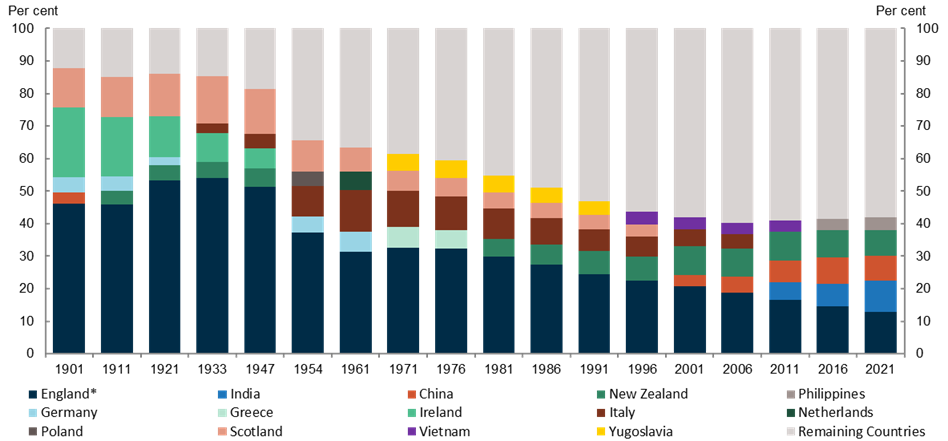The overseas born population has become more diverse over time, comprising of 236 overseas countries of birth in 2021.

Source. Centre for Population analysis of ABS Historical Population Data
*In 1901 England includes both England and Wales. From 1911 onward England does not include Wales.
Text description
Text description of Chart 1: Australia’s overseas born population by proportion: Top 5 countries
This graph shows the percentage of overseas migrants from a country as a proportion of the total migrant population.
The main take aways are:
- The diversity in Australia’s overseas born population has increased since 1901.
- The top five countries consisted of 88 per cent of Australia’s overseas born population in 1901, while in 2021 the top five countries consisted of 42 per cent of the overseas born population.
- Italy became a top five country in 1933 and would only fall out of the top five in 2011.
- Ireland would remain in the top 5 from 1901 until 1947.
- Yugoslavia would be in the top 5 from 1971 until its break up, which meant that it fell out of the top 5 in 1996 and was replaced by Vietnam.
- In 2011 India became part of the top 5 and in 2021, it became the second largest overseas born population in Australia.
The (re)emergence of China and the emergence of India as top 5 countries
In 1901, four of Australia’s top five countries of birth were in Europe and one was in Asia. By 2021, one was in Europe and three were in Asia. China was in the top five at Federation due to the attraction of the Gold Rush and a series of internal crises in China from 1849 and 1887. The proportion of people born in China started to decline as the Gold Rush ended and the White Australia Policy was enacted.[1] Since 2001, the main sources of Australia’s overseas born population growth have been from those born in India and China – which are the 2nd and 3rd largest overseas born populations in Australia in 2021. The growth in migrants from these countries is likely due to Australia’s strong labour market and university sector as well as Australia’s geographic proximity.[2]
Why the majority overseas born population is shifting from Europe
Key reasons for the fall in European born populations include moving away from a discriminatory immigration system and assisted migration programs in the 1970s and the European Union’s freedom of movement laws, which have made it relatively easier and cheaper for Europeans to access the labour market across Europe.[3] In addition, Europe’s ageing population will lower the number of people who are likely to migrate.[4] An ageing European born population in Australia has also contributed to the decline in these overseas born populations.[5] For an overseas born population to remain large, constant high levels of migrants from the home country are needed to replace deaths – this is because the children of overseas born people are counted as Australian born.
Close ties with England and New Zealand remain
England still holds the largest proportion of overseas born population despite having fallen from a share of 32.7 per cent in 1971 to 12.9 per cent in 2021. The actual number of people born in England has increased by 77,614 people since 1971.[6] Between 1911 and 1947, New Zealand born people were in the top five before being displaced by higher levels of European migration. Since 1981, New Zealand born people have come back into the top five, reflecting the freedom of mobility agreement between Australia and New Zealand that was established in 1973.[7] Under these agreements, New Zealanders can enter Australia to work, visit and live without the requirement to apply for a visa beforehand.
Footnotes
[1] National Museum of Australia, Explore the Harvest of Endurance scroll, 2023
[2] Centre for Population, 2023 Population Statement, 2023
[3] European Commission, Free movement – EU nationals,2024
[4] European Commission, Population structure and ageing, 2024
[5] Commonwealth of Australia, A history of the department of migration: Managing Migration to Australia, 2017
[6] Australian Bureau of Statistics, Historical Population,2023
[7] Klapdor, M. and Love, S., New Zealanders in Australia: a quick guide, 2020
Downloads
Snapshot – Changes in Australia’s overseas born population since Federation PDF 263 kB
Snapshot – Changes in Australia’s overseas born population since Federation DOCX 194 kB